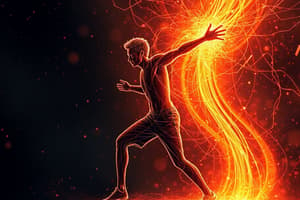Podcast
Questions and Answers
Which part of the motor system is responsible for the adjustment of body posture and providing a stable background for movement?
Which part of the motor system is responsible for the adjustment of body posture and providing a stable background for movement?
- Corticospinal tract
- Extrapyramidal pathway (correct)
- Cerebellum
- Basal ganglia
What regulates postural reflexes by modifying muscle tone?
What regulates postural reflexes by modifying muscle tone?
- Frontal cortex
- Cerebellum (correct)
- Motor neurons
- Basal ganglia
Which descending tract is responsible for voluntary motor activities?
Which descending tract is responsible for voluntary motor activities?
- Corticospinal tract (correct)
- Corticobulbar pathway
- Extrapyramidal pathway
- Basal ganglia
Which structure in the inner ear responds to head movements in different planes and helps maintain posture?
Which structure in the inner ear responds to head movements in different planes and helps maintain posture?
What provides information for reflex control of equilibrium in maintaining posture?
What provides information for reflex control of equilibrium in maintaining posture?
What is the state of continuous and passive contraction of muscles that is essential for maintaining posture?
What is the state of continuous and passive contraction of muscles that is essential for maintaining posture?
Which part of the brain facilitates gamma motor neurons in the spinal cord via cerebello-vestibulo-spinal neurons?
Which part of the brain facilitates gamma motor neurons in the spinal cord via cerebello-vestibulo-spinal neurons?
What type of reflexes are elicited by gravitational pull and involve sustained muscle contraction?
What type of reflexes are elicited by gravitational pull and involve sustained muscle contraction?
What are the tubular structures in the labyrinth or inner ear that respond to head movements in different planes?
What are the tubular structures in the labyrinth or inner ear that respond to head movements in different planes?
Which descending tract adjusts body posture and provides a stable background for movement?
Which descending tract adjusts body posture and provides a stable background for movement?
What integrates afferent pathways from eyes, vestibular apparatus, and proprioceptors to help maintain an upright and balanced position?
What integrates afferent pathways from eyes, vestibular apparatus, and proprioceptors to help maintain an upright and balanced position?
Which part of the motor system provides a stable postural background for voluntary activity?
Which part of the motor system provides a stable postural background for voluntary activity?
What is the definition of posture?
What is the definition of posture?
What is the primary purpose of postural control?
What is the primary purpose of postural control?
What type of balance refers to stability underlying sitting or standing quietly?
What type of balance refers to stability underlying sitting or standing quietly?
Which type of postural control involves movement strategies in response to brief displacements of supporting surfaces?
Which type of postural control involves movement strategies in response to brief displacements of supporting surfaces?
What does proactive (anticipatory) balance control rely on?
What does proactive (anticipatory) balance control rely on?
What does postural stability refer to?
What does postural stability refer to?
What type of postural control refers to the controlling of the body's position in space for the dual purposes of stability and orientation?
What type of postural control refers to the controlling of the body's position in space for the dual purposes of stability and orientation?
What is the framework that refers to postures in which body and body segments are moving?
What is the framework that refers to postures in which body and body segments are moving?
Which type of posture involves postures in which body or body segments are moving?
Which type of posture involves postures in which body or body segments are moving?
Flashcards are hidden until you start studying
Study Notes
- Motor systems consist of high-level planning (frontal and motor cortex), coordination (brainstem, cerebellum, and basal ganglia), and generation of forces (motor neurons and muscles)
- Corticospinal tract, corticobulbar pathway, and extrapyramidal pathway are descending tracts responsible for voluntary motor activities
- Extrapyramidal pathway adjusts body posture and provides a stable background for movement
- Cerebellum and basal ganglia regulate postural reflexes by modifying muscle tone
- Cerebellum facilitates gamma motor neurons in the spinal cord via cerebello-vestibulo-spinal neurons and cerebelloreticulospinal tracts
- Visual and labyrinthine reflexes are important in maintaining posture, with the vestibular nucleus providing information for reflex control of equilibrium
- Semicircular canals are tubular structures in the labyrinth or inner ear that respond to head movements in different planes and help maintain posture
- Muscle tone is the state of continuous and passive contraction of muscles and is essential for maintaining posture along with postural reflexes
- Postural reflexes help maintain the body in an upright and balanced position through the integration of afferent pathways from eyes, vestibular apparatus, and proprioceptors
- Two types of postural reflexes: static reflexes, elicited by gravitational pull and involving sustained muscle contraction, and statokinetic reflexes, elicited by acceleratory displacement and maintaining a stable postural background for voluntary activity.
Studying That Suits You
Use AI to generate personalized quizzes and flashcards to suit your learning preferences.




